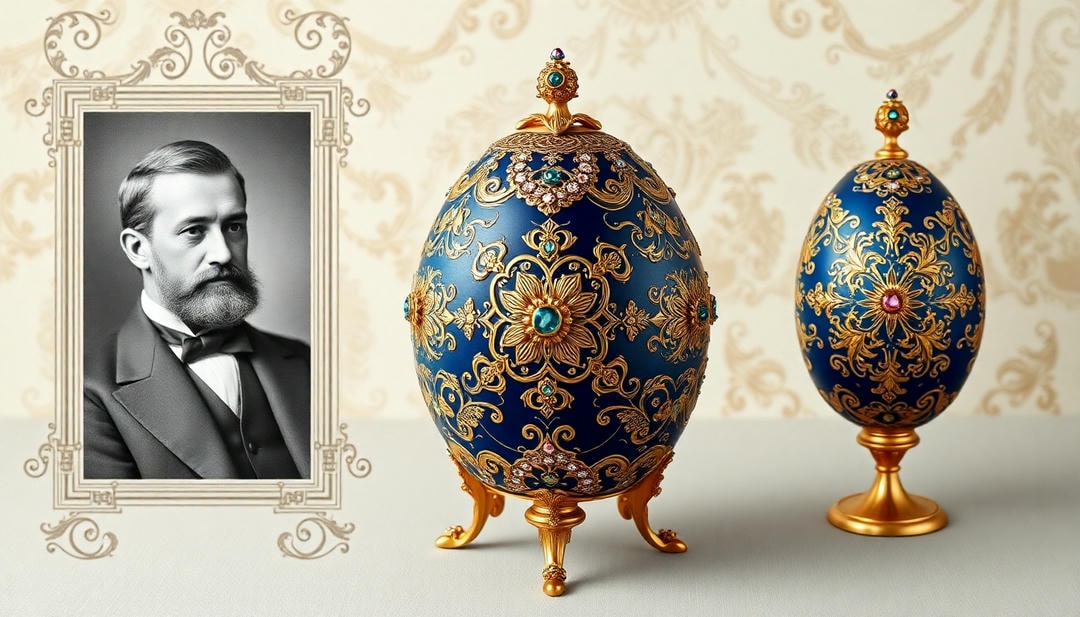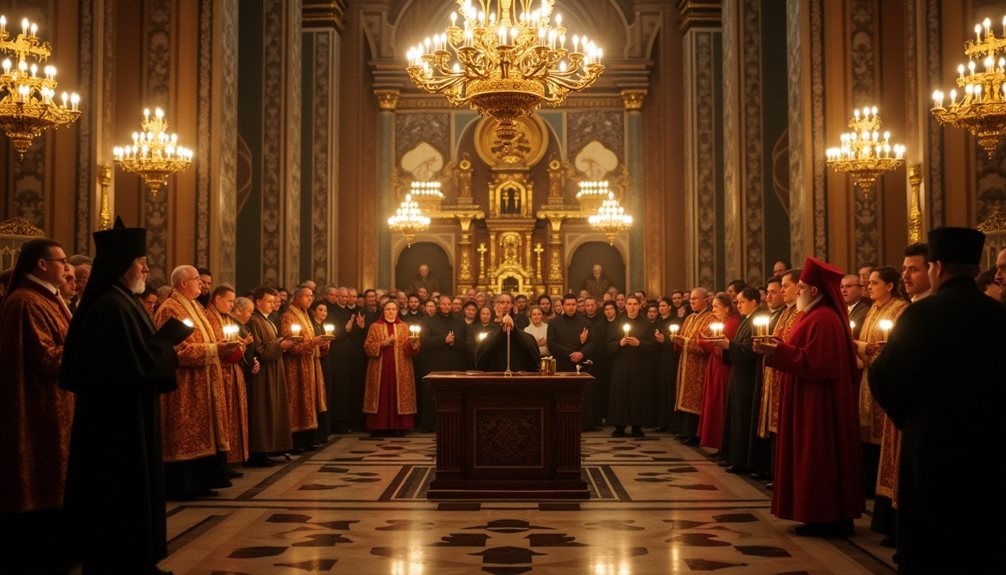Understanding Peter Carl Fabergé’s early life provides valuable insight into his later artistic achievements. Born in Saint Petersburg, Russia, Fabergé grew up in a culturally rich urban environment. His family’s heritage and extensive travels exposed him to diverse artistic traditions, laying the groundwork for his innovative craftsmanship and iconic creations, such as the Fabergé eggs.
His Early Life

Peter Carl Fabergé, born on May 30, 1846 (Old Style May 18), in Saint Petersburg, Russia, was the son of Gustav Fabergé, a Baltic German jeweler of Huguenot descent, and Charlotte Jungstedt, the daughter of Danish painter Karl Jungstedt. His family’s lineage traced back to French Huguenots who fled France after the revocation of the Edict of Nantes, eventually settling in Russia via Germany and the Baltic region. This rich cultural heritage would later influence Peter Carl’s cosmopolitan approach to his craft.
In 1860, Gustav retired and moved the family to Dresden, Germany, leaving his jewelry business in Saint Petersburg under the management of Hiskias Pendin. During this time, young Carl began his formal education at the Dresden Handelsschule (trade school), where he studied business fundamentals. His education extended beyond academics; he embarked on a Grand Tour of Europe, a formative journey that exposed him to diverse artistic traditions and technical expertise. He studied under master goldsmiths in Germany, France, and England, attended Schloss’s Commercial College in Paris, and immersed himself in the collections of Europe’s leading museums. Notably, he apprenticed with Josef Friedman in Frankfurt-am-Main, a jeweler renowned for his exceptional craftsmanship.
Fabergé returned to Saint Petersburg in 1864 at the age of 18 to join his father’s firm. Despite his youth, he continued refining his skills under Pendin’s mentorship while building connections with curators at the Hermitage Museum. By working closely with these experts and volunteering at the museum, he deepened his understanding of historical art and techniques. These early experiences laid the foundation for Fabergé’s future innovations and his ascent as one of history’s most celebrated jewelers.
The Influence of Russian Culture
As one explores the world of Fabergé, it becomes clear that Russian culture profoundly shaped his artistic vision. Influenced by rich Russian folklore, Fabergé infused his creations with cultural symbolism that resonated with national identity. His work reflected artistic traditions that celebrated the beauty of Russia’s heritage, while also embracing innovative craftsmanship techniques that distinguished his eggs. Historical influences, such as the opulence of the Romanov dynasty, provided a backdrop for his artistry, merging tradition with personal expression. This blend of cultural elements allowed Fabergé to create pieces that transcended mere ornamentation, embodying the spirit of a nation.
Mastering the Craft of Egg-Making
To master the intricate craft of egg-making, one must embrace both technical precision and artistic creativity. This art form thrives at the intersection of meticulous craftsmanship and inspired design, transforming simple materials into extraordinary works of art.
Egg-making encompasses a variety of techniques, including enameling, engraving, and intricate metalwork. Each method requires patience, precision, and an eye for detail. For instance, enameling involves layering molten glass onto a metal surface, a process that demands both technical skill and an artistic sensibility to achieve vibrant colors and textures. Similarly, engraving and filigree work allow artisans to create delicate patterns that enhance the egg’s overall aesthetic.
Artistic inspiration often arises from diverse sources such as nature, history, or personal experiences. These influences guide the creative vision of an artisan, breathing life into each piece. By experimenting with color palettes, textures, and patterns, artists develop unique styles that push the boundaries of traditional design. This fusion of inspiration and innovation is what elevates egg-making from mere craft to high art.
The true mastery of this craft lies in balancing its technical rigor with creative freedom. While the process demands precision and discipline, it also offers endless opportunities for self-expression. This duality allows artisans to transform raw materials—gold, enamel, gemstones—into timeless masterpieces.
The Rise to Prominence
Among the many forms of egg-making artistry, Fabergé eggs stand out as unparalleled symbols of opulence and ingenuity. Their story is not just one of exquisite craftsmanship but also a tale of cultural significance and historical legacy.
The Origins of Fabergé Eggs
The legacy began in 1885 when Tsar Alexander III commissioned Peter Carl Fabergé to create a unique Easter gift for his wife, Maria Feodorovna. The result was the first Imperial Fabergé Egg—a white enamel shell containing a golden yolk, which housed further surprises like a golden hen and a miniature crown. This tradition continued under Nicholas II, who gifted these eggs to his wife and mother annually until 1916.
Craftsmanship Meets Innovation
Fabergé revolutionized traditional jewelry-making techniques by incorporating innovative designs and hidden surprises within each egg. From needlepoint motifs to intricate lattices adorned with diamonds and pearls, every creation was a marvel of both engineering and artistry. These eggs were not merely decorative but also functional; some featured clocks or mechanical elements like the famous Rothschild Egg with its diamond-set cockerel that pops out on the hour.
A Symbol of Status and Wealth
Fabergé eggs quickly became coveted treasures among European aristocracy. Families like the Rothschilds and Kelches commissioned their own luxurious versions. However, their production ceased after the Russian Revolution in 1917 when Fabergé fled Russia. Today, these eggs are rare collectibles worth millions—some fetching auction prices as high as $16.5 million.
Modern Legacy
Of the 57 Imperial eggs created by Fabergé, many are now housed in museums or private collections worldwide. Notable collectors include Viktor Vekselberg, whose museum in St. Petersburg displays 15 Imperial eggs. Meanwhile, seven Imperial eggs remain missing—a mystery that continues to intrigue historians and collectors alike.
The Creation of the Iconic Fabergé Eggs

With Fabergé’s rise to prominence firmly established, the creation of his iconic eggs reveals not just a mastery of craftsmanship but a profound understanding of the desires of the Russian elite.
You can appreciate how each piece embodies intricate details and innovative designs, capturing the essence of opulence. Fabergé ingeniously blended traditional techniques with modern aesthetics, ensuring that each egg wasn’t merely a decorative object but a symbol of status.
As you explore these treasures, you’ll discover how they reflect the aspirations and emotions of a society yearning for beauty, freedom, and expression in a rapidly changing world.
Legacy and Impact on Decorative Arts
The legacy of Fabergé eggs is a cornerstone of the decorative arts, showcasing how artistry can transcend time and influence generations. Peter Carl Fabergé revolutionized artistic craftsmanship by blending traditional techniques with bold innovation. His meticulous attention to detail and use of diverse materials—such as enamel, gemstones, and rock crystal—set a standard for artisans worldwide.
Fabergé’s workshop not only produced the iconic eggs but also expanded its repertoire to include jewelry, carved stones, and luxurious objects inspired by global influences such as Japanese and French art. This fusion of styles encouraged experimentation among artists, fostering a spirit of creativity that continues to shape modern decorative arts. For example, his incorporation of avant-garde elements into traditional designs demonstrated how historical motifs could coexist with contemporary aesthetics.
Interestingly, Fabergé eggs were not merely decorative but functional art pieces. Many contained surprises like miniature portraits, automatons, or intricate mechanisms, reflecting the Romanov family’s personal stories and marking milestones in their history. This concept of embedding narrative within art has inspired modern designers to create pieces that are both visually stunning and emotionally resonant.
Today, Fabergé’s influence is evident in exhibitions worldwide, where his creations are celebrated as masterpieces that bridge the gap between luxury and artistic innovation. The Walters Art Museum’s display of Fabergé eggs alongside other Russian crafts exemplifies how his legacy continues to illuminate the beauty and complexity of decorative arts.
The Enduring Allure of Fabergé Eggs
Fabergé eggs remain unparalleled symbols of opulence and craftsmanship, captivating collectors and historians alike. Their allure lies in their ability to encapsulate both artistry and historical significance. Each egg is a testament to the ingenuity of Fabergé’s workshop, where teams of jewelers, metalsmiths, and designers collaborated to create these intricate treasures.
The tradition began in 1885 when Tsar Alexander III commissioned the first egg as an Easter gift for his wife. Its success birthed an annual tradition that continued under Nicholas II until the fall of the Romanovs in 1917. Despite their origins in imperial Russia, Fabergé eggs have transcended their historical context to become icons of global art history. They are often referred to as the “Mona Lisa” of decorative arts due to their cultural resonance.
One fascinating aspect is the hidden surprises within each egg—miniature sculptures, clocks, or even mechanical birds—that delighted their recipients. These features highlight the intersection of engineering and artistry, making each egg a marvel not just for its aesthetic beauty but also for its technical sophistication.
In modern times, Fabergé eggs have become coveted collectibles, with some fetching tens of millions at auctions. Their rarity—only 43 of the original 50 imperial eggs are known to exist—and historical significance make them prized possessions for museums and private collectors alike. Notable figures like Malcolm Forbes helped elevate their status by amassing significant collections that showcased their enduring appeal.
The revival of the House of Fabergé has further cemented their legacy. Contemporary creations pay homage to the original masterpieces while incorporating modern elements that resonate with today’s audience. This blend of tradition and innovation ensures that Fabergé eggs continue to inspire admiration across generations.
Ultimately, Fabergé eggs symbolize the timeless pursuit of beauty and creativity. Their intricate designs and rich histories remind us that art can transcend its era, connecting us to universal themes of elegance, ingenuity, and human expression.




